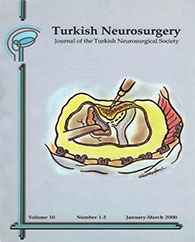Turkish Neurosurgery
2000 , Vol 10 , Num 1-2
Associate Professor, University of Ankara School of Medicine, Department of Neurosurgery, Ankara
Detailed knowledge of the microneuroanatomy of the skull base enables the neurosurgeon to make more aggressive surgical approaches. The most important goal in skull base surgery is minimizing retraction of the brain tissue, since excessive retraction may lead to cerebral contusion, intracerebral hemorrhage, and neuronal damage. The ideal cranial surgery involves no brain retraction, and neurosurgeons have adopted various skull base approaches with this goal in mind. One such method is orbitozygomatic approach. Between 1992 and 1998, 55 patients underwent surgery via a combined frontotemporal-orbitozygomatic approach to address tumors of the sphenoid wing, cavernous sinus, and orbit. Nineteen of the patients had orbital tumors and 36 had other types of skull base tumors. There were no postoperative complications associated with this technique, and there was no mortality. All patients returned to their previous occupations, and are living independently. The main advantages of the orbitozygomatic approach are (1) enhanced orbital, middle, and anterolateral cranial exposure, and (2) reduced need for brain retraction. The only disadvantage of this technique is the operative time required, which is longer than the standard pterional approach. The orbitozygomatic approach is a useful method for managing extensive tumors of the anterolateral skull base.
Keywords :
Cavernous sinus, infratemporal fossa, orbitozygomatic approach, orbita, skull base
Corresponding author : Haluk Deda





